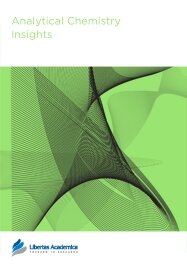

Publication Date: 03 Feb 2010
Type: Original Research
Journal: Analytical Chemistry Insights
Citation: Analytical Chemistry Insights 2010:5 1-14
doi: 10.4137/ACI.S3148

A new liquid chromatography (LC)-negative ion electrospray ionization (ESI)–tandem mass spectrometry (MS/MS) method with post-column addition of ammonia in methanol has been developed for the analysis of acid herbicides: 2,4-dichlorophenoxy ace- tic acid, 4-chloro-o-tolyloxyacetic acid, 2-(2-methyl-4-chlorophenoxy)butyric acid, mecoprop, dichlorprop, 4-(2,4-dichlorophenoxy) butyric acid, 2,4,5-trichlorophenoxy propionic acid, dicamba and bromoxynil, along with their degradation products: 4-chloro-2- methylphenol, 2,4-dichlorophenol, 2,4,5-trichlorophenol and 3,5-dibromo-4-hydroxybenzoic acid. The samples were extracted from the surface water matrix using solid-phase extraction (SPE) with a polymeric sorbent and analyzed with LC ESI- with selected reaction monitoring (SRM) using a three-point confirmation approach. Chromatography was performed on a Zorbax Eclipse XDB-C18 (50 × 4.6 mm i.d., 1.8 µm) with a gradient elution using water-methanol with 2 mM ammonium acetate mobile phase at a flow rate of 0.15 mL/min. Ammonia in methanol (0.8 M) was added post-column at a flow rate of 0.05 mL/min to enhance ionization of the deg- radation products in the MS source. One SRM transition was used for quantitative analysis while the second SRM along with the ratio of SRM1/SRM2 within the relative standard deviation determined by standards for each individual pesticide and retention time match were used for confirmation. The standard deviation of ratio of SRM1/SRM2 obtained from standards run on the day of analysis for different phenoxyacid herbicides ranged from 3.9 to 18.5%. Limits of detection (LOD) were between 1 and 15 ng L-1 and method detection limits (MDL) with strict criteria requiring <25% deviation of peak area from best-fit line for both SRM1 and SRM2 ranged from 5 to 10 ng L-1 for acid ingredients (except dicamba at 30 ng L-1) and from 2 to 30 ng L-1 for degradation products. The SPE-LC-ESI- MS/MS method permitted low nanogram-per-liter determination of pesticides and degradation products for surface water samples.
PDF (732.55 KB PDF FORMAT)
RIS citation (ENDNOTE, REFERENCE MANAGER, PROCITE, REFWORKS)
BibTex citation (BIBDESK, LATEX)
XML
PMC HTML


I have published more than thirty research papers in internationally reputed high impact factor journals including Libertas Academica publications, Proteomics Insights and Analytical Chemistry Insights. I have no hesitation in saying that Proteomics Insights is highly efficient for its rapid and high quality review process and keeping the authors informed at each stage of the publication process. I recommend this journal for students, teachers and research workers who wish to publish their work. ...
Facebook Google+ Twitter
Pinterest Tumblr YouTube